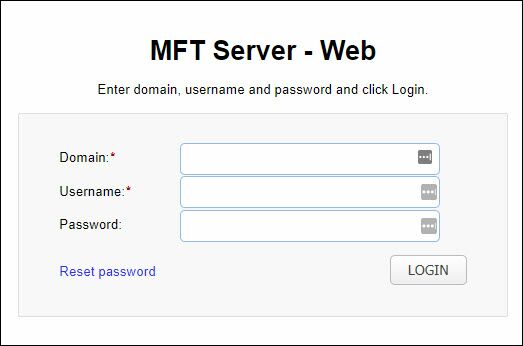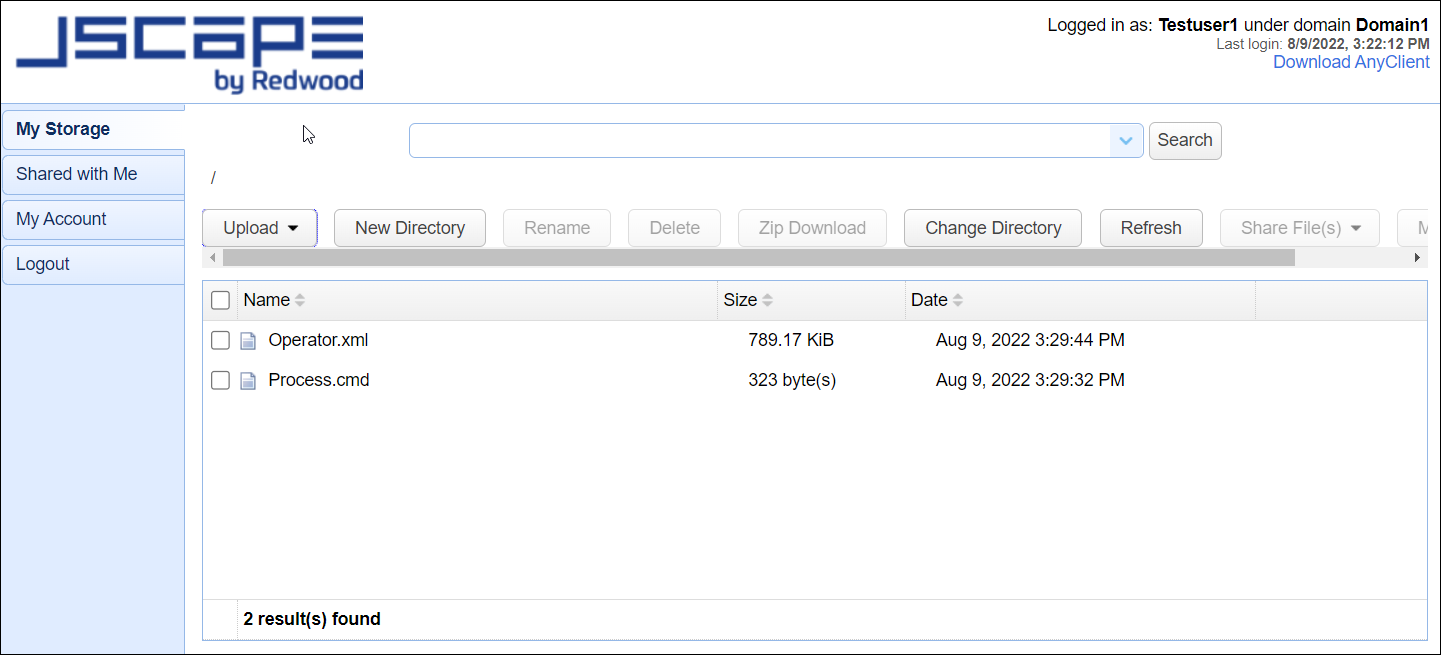MFT Server Web Client has all the common functions of a file transfer client without having to install file transfer client software on your end-users computers. All user permissions and virtual paths are observed when using MFT Server Web Client.
Figure 25

Domain - The name of the domain to connect to. This is the name of the domain as identified Domain Name column of MFT Server Manager, not the IP address or hostname although these may be the same.
Username - The account username.
Password - The account password.
Reset password - Allows user to reset lost password.
After logging in, you will see your storage information,as depicted in Figure 32.
Figure 32

If you click on My Account on the left-hand side of the page, you will see information related to your account, as depicted in Figure 115.
Figure 115

Personal Information
This section is available to all users and may be used to update the name, email address, company name, phone number, theme, and password for a user account.
Theme - This is the theme used for the MFT Server Web Client application (excluding the log in page).
The theme field is initially blank for a new user. When blank, the theme configured in the MFT Server Manager is used, set on the Domain associated with the user, under SERVICES > Listeners > HTTP/S. To change the application theme for the individual MFT Server Web Client user, click on the check box to the left of the Theme field, then click on the Change button. A theme panel will appear on the right-hand side of the page, displaying “Custom Colors” at the top of the panel, followed by all the preset themes, displayed in individual boxes, that you can select from.
Selecting a preset theme with no color customization:
In the theme panel, click on the box of the desired preset theme. After making a selection, the MFT Server Web Client UI’s theme will update temporarily to display the currently selected theme so you can preview it before committing to the change. When you find a theme you like, click anywhere outside of the theme panel, which will revert the Client UI back to its current theme (until you save/refresh the UI). You will also see your currently selected theme updated in the Theme field. To save your theme choice, click on the Apply button, or alternatively click on the Discard button to cancel the selection. If you save your selection, you will need to refresh the browser to see the new theme take effect.
Selecting a preset theme and customizing it:
This option is used to customize one of the preset themes available in the theme panel. First, select a theme that you would like to customize. Next, access the Custom Colors section of the theme panel and determine which item(s) you want to change (e.g. Panel text, Panel border, etc.). Click on the color box associated with the item you wish to customize. Select the desired color from the displayed choices. After you are satisfied with your one or more color customizations, click the Set Custom button. After doing so, the theme panel will be removed, the Theme field will display the name of your selected theme followed by "custom" - e.g. metro-gray (custom), and the MFT Server Web Client UI's theme will revert to its current theme (until you save/refresh the UI). Click the Apply button to save the custom theme or click the Discard button to cancel the theme change. If you save your selection, you will need to refresh the browser to see the new theme take effect. If the customized theme field is later modified and replaced with a new theme (customized or not), the prior customized theme, no longer in use, will return to its original (factory default) preset color scheme.
Note: The theme used for the MFT Server Web Client log in page is set in the MFT Server Manager UI, configured in Settings > MISCELLANEOUS > Web > Web tab.
Public Key Authentication
This section can be used to generate a key pair for use in public key authentication (SFTP). When generating a key pair or importing a public key the public key is automatically placed in the .ssh/key.pub file relative to the users root login directory on the server. When generating a key pair the user is prompted to store the private key on their system. Note, private keys should never be stored on the server, except for purposes of connecting to other remote servers.
OpenPGP Encryption
This section can be used to generate an OpenPGP key pair for use in encrypting files uploaded to virtual directories.
Domain Administration
This section is only available to domain administrators and may be used to manage users.
Quotas
This section displays any bandwidth quota or directory monitor quota information for the user.
Contacts
This section can be used to manage contacts for use in ad-hoc file transfers.
Ad-Hoc Activity
This section can be used to manage ad-hoc emails sent by the user.
Drop Zones
This section shows drop zone information for the user.
See also
Assigning domain administrators